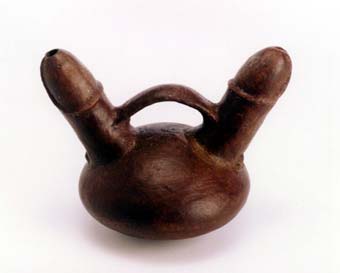Vicus Double-Spouted Stirrup Bottle With Phallus, 300 BCE - 300 CE
Terracotta
8
PF.3381
To date, the Vicus style is something of an enigma. It appears to have been extremely limited, both geographically and temporally. Its vessel forms and iconographic motifs are similar to...
To date, the Vicus style is something of an enigma. It appears to have been extremely limited, both geographically and temporally. Its vessel forms and iconographic motifs are similar to those of the better known Moche style, yet its color, modeling, and surface decoration seems more Ecuadorian. As further archaeological information becomes available, it will be interesting to reconstruct the precise antecedents of the Vicus style, and to determine its role in the evolution of the Peruvian ceramic tradition. Until then, we can sit back and enjoy the pure visual aesthetics of these fascinating vessels.
This is a very interesting vessel, which creatively displays to us the extraordinary organ of the male species. It symbolizes the perpetuation of life and active power! The phallus was also the ancient symbol of the propagation of cosmic forces. This vessel most probably held a special liquid at one time. This special liquid would have poured out of the phallus tip and is an accurate representation of where the life-giving semen would pour forth from the male. Thus, this may have been an important ritual vessel for fertility and abundance. During a time and place where nudity was perfectly acceptable, this vessel did not make people blush or giggle as it may today. Instead, it was a divine representation of the sacred source of fertility and power.
This is a very interesting vessel, which creatively displays to us the extraordinary organ of the male species. It symbolizes the perpetuation of life and active power! The phallus was also the ancient symbol of the propagation of cosmic forces. This vessel most probably held a special liquid at one time. This special liquid would have poured out of the phallus tip and is an accurate representation of where the life-giving semen would pour forth from the male. Thus, this may have been an important ritual vessel for fertility and abundance. During a time and place where nudity was perfectly acceptable, this vessel did not make people blush or giggle as it may today. Instead, it was a divine representation of the sacred source of fertility and power.



